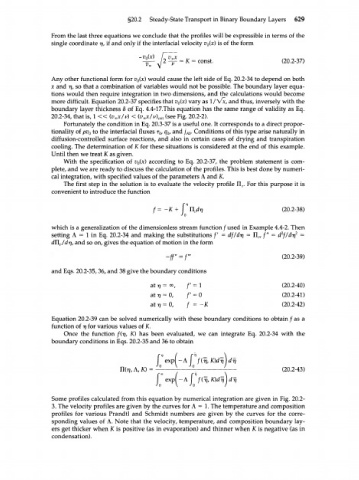Page 649 - Bird R.B. Transport phenomena
P. 649
§20.2 Steady-State Transport in Binary Boundary Layers 629
From the last three equations we conclude that the profiles will be expressible in terms of the
single coordinate 77, if and only if the interfacial velocity v (x) is of the form
o
(20.2-37)
Any other functional form for v (x) would cause the left side of Eq. 20.2-34 to depend on both
Q
x and 17, so that a combination of variables would not be possible. The boundary layer equa-
tions would then require integration in two dimensions, and the calculations would become
more difficult. Equation 20.2-37 specifies that v (x) vary as 1/Vx, and thus, inversely with the
o
boundary layer thickness 8 of Eq. 4.4-17.This equation has the same range of validity as Eq.
20.2-34, that is, 1 < < (v^x/v) < (i> */i>) (see Fig. 20.2-2).
x cril
Fortunately the condition in Eq. 20.3-37 is a useful one. It corresponds to a direct propor-
tionality of pv to the interfacial fluxes т , q , and j . Conditions of this type arise naturally in
0 0 0 AQ
diffusion-controlled surface reactions, and also in certain cases of drying and transpiration
cooling. The determination of К for these situations is considered at the end of this example.
Until then we treat К as given.
With the specification of v (x) according to Eq. 20.2-37, the problem statement is com-
o
plete, and we are ready to discuss the calculation of the profiles. This is best done by numeri-
cal integration, with specified values of the parameters Л and K.
The first step in the solution is to evaluate the velocity profile П,. For this purpose it is
г
convenient to introduce the function
f= -K+ P I M T J (20.2-38)
Jo
which is a generalization of the dimensionless stream function / used in Example 4.4-2. Then
2
setting Л = 1 in Eq. 20.2-34 and making the substitutions /' = df/d-q = U f" = d f/dr) 2 =
v/
dU /drj, and so on, gives the equation of motion in the form
v
-ff"=f'" (20.2-39)
and Eqs. 20.2-35, 36, and 38 give the boundary conditions
at r/ = oo, /' = i (20.2-40)
at7j = 0, f' = 0 (20.2-41)
at 7) = 0, f = -K (20.2-42)
Equation 20.2-39 can be solved numerically with these boundary conditions to obtain / as a
function of г] for various values of X.
Once the function /(ту, К) has been evaluated, we can integrate Eq. 20.2-34 with the
boundary conditions in Eqs. 20.2-35 and 36 to obtain
J expl-Aj fi^
j
J
— )
IKTJ, Л, Ю = — ) { (20.2-43)
f
f I f \
exp -Л
\
Some profiles calculated from this equation by numerical integration are given in Fig. 20.2-
3. The velocity profiles are given by the curves for Л = 1. The temperature and composition
profiles for various Prandtl and Schmidt numbers are given by the curves for the corre-
sponding values of Л. Note that the velocity, temperature, and composition boundary lay-
ers get thicker when К is positive (as in evaporation) and thinner when К is negative (as in
condensation).

